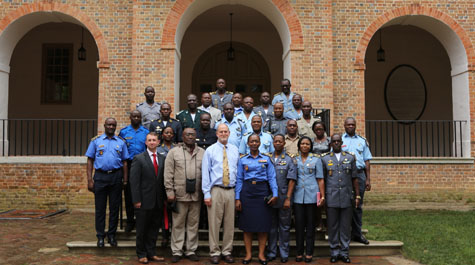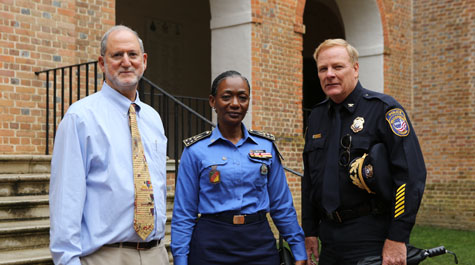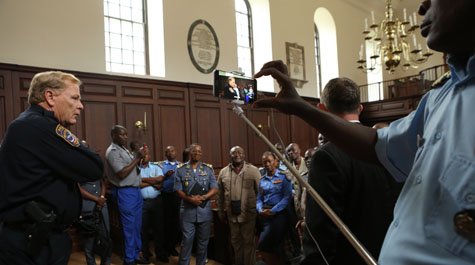W&M visited by 27 UN peacekeepers from Africa
The Wren Building gets its share of diverse visitors on a daily basis, but on Friday afternoon, one tour included an especially unique group of guests: 27 senior officers from 10 African nations, including Cameroon, Chad and the Ivory Coast, who serve as police on United Nations peacekeeping missions.
The men and women, mostly uniformed, stopped by William & Mary during a two-week tour of the U.S., primarily in Washington, D.C., and New York, to visit with Harvey Langholtz, professor of psychology. Langholtz, an expert on the psychology of peacekeeping, editor of The Journal of International Peacekeeping, founder of the Peace Operations Training Institute, and author of The Psychology of Peacekeeping, met with the group to discuss training strategies for U.N. peacekeepers, which include military personnel and police forces.
“The 27 men and women who serve as police in their own nations and on U.N. peacekeeping missions are on the front line of bringing stability and security to what can sometimes be a dangerous and chaotic environment,” he said. “They face the same petty and not-so-petty crimes that will exist in any society, and they confront terrorism in a chaotic region where predators will prey on civilians.”
Langholtz, who’s been visited by international peacekeepers from Russia to the Netherlands in the past, said this is the largest group of peacekeepers that has visited him thus far. During their meeting, Langholtz discussed with the officers the process of transitioning a region from the chaos and anarchy of war to peace, stability, and self-sufficiency, and the essential role police play in facilitating that. He also discussed ways African nations can use e-learning to train military personnel and police to deal with these issues.
“There are currently several regions in Africa where there is unrest and conflict,” he said. “The nature of these conflicts will vary, but they often take place in fragile states where the central government is not able to maintain control or security and warring factions and spoilers will seek power through the use of force.”
After the meeting, the officers — some toting cameras, iPads, even a selfie stick — were treated to a tour of the Wren Building, followed by a visit from Williamsburg Chief of Police Dave Sloggie and a guided walk through Colonial Williamsburg.
In addition to meeting with international peacekeepers on W&M turf, Langholtz frequently travels around the world to give presentations on peacekeeper training. At the end of June, he will visit the U.N. headquarters in New York, and will speak at an international meeting in Sarajevo, Bosnia and Herzegovina, in September.
“I have every respect for all police – Williamsburg, New York, Orlando, Paris, Yaoundé, Kinshasa, and others worldwide,” said Langholtz. “These are the true peacekeepers who protect and serve us all in our home nations.”
 Skip to main content
Skip to main content



